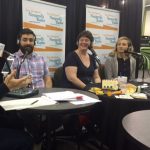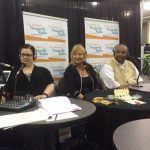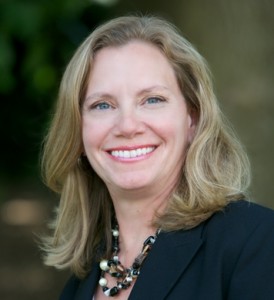
My Guests:
Evan Briggs & Gwenn Cagann: Virtual Events
Evan Briggs and Gwenn Cagann share their lessons from 25 virtual galas, which include takeaways for your next hybrid event. They’re both with Wingo NYC.


Josh Riman & Mike Yamagata: Design For Non-Designers
Wrapping up our 21NTC coverage, it’s a crash course in good design, covering fundamentals like color, type and hierarchy. Step outside your comfort zone with Josh Riman and Mike Yamagata, both from Great Believer.


Listen to the podcast
Podcast: Play in new window | Download
Get Nonprofit Radio insider alerts!
I love our sponsors!
![]() Turn Two Communications: PR and content for nonprofits. Your story is our mission.
Turn Two Communications: PR and content for nonprofits. Your story is our mission.
Sendinblue: The only all-in-one digital marketing platform empowering nonprofits to grow.
We’re the #1 Podcast for Nonprofits, With 13,000+ Weekly Listeners
Board relations. Fundraising. Volunteer management. Prospect research. Legal compliance. Accounting. Finance. Investments. Donor relations. Public relations. Marketing. Technology. Social media.
Every nonprofit struggles with these issues. Big nonprofits hire experts. The other 95% listen to Tony Martignetti Nonprofit Radio. Trusted experts and leading thinkers join me each week to tackle the tough issues. If you have big dreams but a small budget, you have a home at Tony Martignetti Nonprofit Radio.
View Full Transcript
Processed on: 2021-08-13T15:27:34.892Z
S3 bucket containing transcription results: transcript.results
Link to bucket: s3.console.aws.amazon.com/s3/buckets/transcript.results
Path to JSON: 2021…08…554_tony_martignetti_nonprofit_radio_20210816.mp3.557377123.json
Path to text: transcripts/2021/08/554_tony_martignetti_nonprofit_radio_20210816.txt
[00:00:10.74] spk_5:
Hello and welcome to tony-martignetti
non profit [00:02:17.44] spk_1:
Radio big non profit ideas for the other 95%. I’m your aptly named host of your favorite abdominal podcast. Oh and I’m glad you’re with me. I’d get slapped with a diagnosis of interception if you blocked me up with the idea that you missed this week’s show virtual events. Evan Briggs and Gwen Sagen share their lessons from 25 virtual galas which include takeaways for your next hybrid event. They’re both with wing go N.Y.C. and designed for non designers Wrapping up our 21 NTC coverage. It’s a crash course in good design covering fundamentals like colour type and hierarchy. Step outside your comfort zone with josh, Lyman and Mike Yamagata, both are from great believer. This week’s conversations are from 21 NTC and they wrap up our coverage of the conference and tony state too, sharing really is caring. We’re sponsored by turn to communications pr and content for nonprofits. Your story is their mission turn hyphen two dot C O and by sending blue the only all in one digital marketing platform empowering non profits to grow. tony-dot-M.A.-slash-Pursuant in Blue. Let’s get started. Here is virtual events. Welcome to Tony-Martignetti non profit radio coverage of 21 NTC, you know what that is. It’s the 2021 nonprofit technology conference. We’re sponsored at 21 NTC by turn to communications Turn hyphen two dot C o with me now from wingO N.Y.C. our Evan Briggs and Gwen Sagen Evan is digital fundraising and client engagement manager and Gwen is director of special events fundraising. Welcome Evan. Welcome, Gwen. [00:02:23.64] spk_2:
Thank you. My [00:02:25.41] spk_1:
pleasure. Uh, why doesn’t one of you? Uh, well, I’ll pick otherwise everybody was so polite. You work together and nobody will talk and then I’ll end up having to pick anyway, So, Gwen, uh, since you’re both from window N.Y.C. why don’t you acquaint us what lingo does. [00:03:00.44] spk_2:
Thank you. Wingo is a small fundraising communications and design firm. Um, we have and call ourselves a boutique because we’re so small. We’re 12 people and we specialize in working with nonprofit clients, although we do have some corporate clients, but nonprofit clients that work in the social justice sector. Um and that’s probably about 70% of what we do and the remaining 30% or arts and conservancies and we help nonprofits with their individual giving and major donor fundraising and their special events. [00:03:14.34] spk_1:
All right. And we’re gonna talk about special events. Um are where are each of you in each of you? In N.Y.C. [00:03:21.94] spk_4:
I am in new york city. [00:03:23.84] spk_1:
Okay. Where where what [00:03:25.64] spk_4:
part? Um in Manhattan Health kitchen specifically. [00:03:28.26] spk_1:
Alright, 9th and 10th of [00:03:30.39] spk_4:
What? In between 9th and 10th on 49, [00:03:52.14] spk_1:
Lot of good restaurants. Uh, 9th of from like 43rd and 44th up to like 55th or so, roughly 50, maybe 53. Some a lot Outstanding restaurants all along, 95. I’m envious of your food choices. There’s everything from Afghan. The Zimbabwe is on 9th. I think there was like 10, 12 blocks or so. [00:03:58.44] spk_4:
Yeah, exactly. And it’s like almost feels like europe now with all the outdoor dining, they’ve completely shut down some streets and it’s just quite lovely. [00:04:07.40] spk_1:
Right, right, so not ninth that they didn’t close. 9th of though, have they? [00:04:11.10] spk_4:
Not 9th at but the side streets [00:04:20.84] spk_1:
that go off of it. Right, right. We need folks need ninth, they have to get to haunt tunnel every day, Lincoln Lincoln, I should say in your neighborhood Lincoln tunnel every day. Gwen all right, so gwen, you’re an outlier, you’re not an N.Y.C. Where are you? [00:04:24.94] spk_2:
Um I am actually, although I, when I’m in the city, you know pre pandemic in Boerum Hill Brooklyn. Um and right now though I’m writing out the pandemic in Jackson Wyoming, we have a small family place out here and I came out for a week vacation when things went isolated and haven’t left. [00:04:44.94] spk_1:
Yeah, the week vacation that, that hasn’t ended yet in over [00:04:47.72] spk_2:
a year in the great outdoors. [00:04:49.84] spk_1:
Yeah, cool. So your window, your window Wyoming? [00:04:52.84] spk_2:
Exactly and we have a window India to right now one of our graphic designers is based in India where she was writing about the pandemic and so we’re worldwide. [00:05:06.84] spk_1:
Okay, that’s strictly N.Y.C. alright, your Boerum Hill. So you live in Boerum Hill. Yeah. Remember the park slope food co op by any chance [00:05:13.62] spk_2:
know, but a couple of my colleagues are half of us live in Brooklyn and yeah, so I know it’s changed a lot during the pandemic with the work hours and such, but what a great place. [00:05:57.74] spk_1:
It is a great place and I’m still a member. I live on the beach in north Carolina. I’m still a member of park slope food go up. Uh you know, they suspended the, they suspended the work requirements for the whole year. Now, they’re just slowly getting back into the member work requirement, but it’s optional for several months. And you know, I don’t know when I’ll be back up, but uh I maintain my membership in the go up because before that you could bank your shift, you could do, you could work a bunch of months. Uh you could work a bunch of shifts like in a week or even in a months and have them for subsequent months for many, many months. So I never lived [00:05:58.31] spk_3:
in a community. [00:06:27.74] spk_1:
It’s a great, it is great community park slope food co op shout out. I’m gonna be one of the most distant members. I mean north Carolina, you know, it’s not, it’s not easy to get there, but it’s, I keep my membership, it’s still worth it. All right, so we should be talking about your N.Y.C. you’re not your window N.Y.C. topic, you’re 21 ntc topic, which is a virtual events for the masses inclusive and interactive gatherings, Evan, what what is this all about? You’ve got uh you did like window did like 25 virtual galas in 2020. What you’ve got lessons for us. [00:07:21.34] spk_4:
Yeah, we um, we quickly pivoted to uh throwing virtual events for our clients. A big part of our business, pre pandemic was was in person events, big Gallas and even smaller donors cultivation events and our firm learned quickly how to transform that experience into a virtual experience. Um, and we’ve had great success and continue to have great success um, with the, with the virtual events. Um you know, we create a space virtually on a platform where folks can gather and interact and have a really sort of intimate moment with, with the charity and we’ve found that fundraising has met or exceeded all of our, all of our goals um, for each of our clients and yeah, it’s, it’s something that we think is here to stay and you know, [00:07:31.69] spk_1:
why is that why are virtual events going to continue when we can return safely to in person events? [00:07:37.84] spk_4:
Um, I think people just learned that there’s, there’s so much benefit to having a virtual event. Um [00:07:43.63] spk_1:
you know, [00:07:44.32] spk_4:
one of the most obvious reasons is that so many people can, can gather [00:07:47.87] spk_5:
um from [00:08:17.54] spk_4:
all over the world and you know, the, we suggested to all of our clients that they make these events free to join um and then still offer sponsorships and other ways to donate. One of the big moments that we always have in each of our virtual events is what we call our live ask. So there’s still a moment where, you know, at a typical gala, there’d be a paddle raise or live auction. We’ve adapted that to a virtual moment and you still feel that energy and get to, uh, you know, have a night of successful fundraising with, you know, sometimes up to 1000 people, sometimes more. [00:08:48.94] spk_1:
Okay, Alright. So remaining remaining relevant virtual events and uh, so I gather you have a bunch of, a bunch of ideas, like some new, I don’t know, maybe their new best practices or tips tools, strategies for successful virtual events. Is that, is that right? You’re gonna share a bunch of what you learned, how we’re going to bring in some, uh, inclusivity as well. Do I have that? [00:10:17.94] spk_2:
Yeah, I’ll jump in here. I mean, you know, add on to what Evan said, um, that inclusivity by making it open to a broader range of people, not only your major donors that could afford that $500,000 dinner ticket when we were in person, but also everyone staff clients, People that benefit from the work of the non profit organization, really just reinforce all the positive things about your organization’s community. So the major donors feel great because they’re actually getting to interact with, as I said, some of the people that are benefiting from the programs and you know, it hits home in a really different way. You also get to grow your list. So all of those and we’re saying that, you know, somewhere between twice as many and three times as many people register for these events as you would get in the room. So let’s say you had a 400 person gala at Chelsea piers, see the dinner, you could get a, you know, 800 people registered for your event, usually about 70% of those actually tune in that evening. Um those are 300 new people, you know that you can, you know do some research on prospect with them if they come to the event, they now know about your organization, and so you know it’s a great way to grow your list, it’s really hard to grow your list in in real life, it has been traditionally and so that’s when big benefit in addition to this, just community feel and people really getting to know your organization and be interactive with it. [00:10:27.99] spk_1:
All right, Gwen, let’s stay with you, let’s get into some ideas that you have about producing successful events. What should we start with? [00:13:46.24] spk_2:
Yeah, I mean, one of the biggest things is with virtual events is to be creative, there is no one cookie cutter way to do it for all in our opinion, you know, we do, Evan can talk later about some of the platforms we use if that’s going to be relevant to this conversation, but you know, we have a platform that works, but it’s really flexible for whatever program the client wants to put on and, you know, we highly recommend not just translating, you know, speakers at a podium to the virtual world. We want to make it much more engaging and exciting, fast paced dynamic. Um and so one of the biggest things we like to do is a little bit of what we’re doing today, have your speakers in conversation, and that could be honorees in conversation with someone who would traditionally present them in the world world, but it doesn’t even have to be that formulaic or formatted. It can be um an honoree in conversation with an expert in the field of what, you know, let’s say you’re doing immigration or foster care work, who are those experts in the field, let’s work them in because that’s a big part of what your audience is going to be engaged in hearing from. Obviously if you can get some celebrities, it’s wonderful. Um we do find that we’ve been able to get yeses for more celebrities in the virtual world than we did in the real world. I think part of it is because um even though there’s an event day that we stream on this event, we do pre record most of it, that’s the, you know, behind the scenes real life um reality. Um we primarily do that because we want to ensure a seamless experience. Um and prerecorded can still be totally relevant, totally topical. Um you know, during the heights of the pandemic and the craziness of the previous administration, we did end up when there was some, something crazy in the news, we did end up re recording, say um an executive directors piece, very, very close to the event because something relevant happened that, you know, we don’t want to be tone deaf about. So anyway, pre recording really helps as well. And then it helps again with those high profile people, whether they be on res or donors, um you know, who you want to get speakers or celebrities because um you know, you can do it around their schedule. Um also we just find that some very many of these high profile people who may have had just insane travel schedules, you know, our were more available and certainly, you know, had such a big urge to get back. So that was a big piece of it. Um the other um thing that we highly recommend is to share the record and share the event. You know, use it more than event day. You can either, you know, distribute it via your blast on your website through um, you know, as the full piece, which is great to do, but then also, you know, create some video clips um and share those unsocial and wherever you can for the relevant audiences. Uh and then I guess the last big piece and and maybe this should be a whole section of conversation today is looking to the future and hybrid event. So you know, depending on when you want to fit that and we can talk about that as well. [00:15:28.54] spk_1:
It’s time for a break. Turn to communications. They help nonprofits like your nonprofit tell compelling stories and gain attention like attention in the Wall Street Journal, the new york Times, the chronicle of philanthropy and lots of other outlets. You’ve been hearing me name, Turn to communications. Your story is their mission turn hyphen two dot c o. Now back to virtual events. I love the idea of recognizing that you’re honorees and celebrities are so much more available for a virtual event and pre recording to, to present during the event. Um honorary, honorary timing can be a bet. Yeah, I’d love to be your honoree, but you know, I’m gonna be in new Zealand that week so I, I can’t do it. But you know, you could record from new Zealand or we can record from your home six weeks in advance. You know, it’s very good, very good point. Maybe that’s obvious it’s probably obvious to those of you who are doing events. Uh, I’m a lay person. I’m just, I’m learning this for the, for the 25 minutes or so that were together. So you spend your time studying this. Um, is that all the, the Evan, is that, is that all the strategies be creative pre record, you know, try to leverage celebrities, celebrity availability, honoree availability, share. Repurpose. Uh We could talk maybe about hybrid any any other tips though before we move onto platforms and resources. [00:16:27.74] spk_4:
Yeah I mean one thing just to add on to the prerecorded tip is you know we do also Sprinkle in um some some live moments and you know and we and we do that strategically so we do reinforce that feeling that this is happening live throughout the event. And then you know we often will have our live moment directly in the middle or in the first half sometimes we’ll open up with a with a live em see that’s another great tip for a virtual event is to to have an EMC who can tie everything together, who’s really energetic um who can end you know can also interact with guests as they’re chatting. Um That really uh we found that the chat is crucial which is um which is why the platform is so so important when producing a virtual event. You know, we uh made a decision not to do our events on our most of our events on zoom because people are you know a little zoomed out and zoomed fatigue. [00:17:08.54] spk_1:
We’re gonna we’re gonna get we’re gonna get to the platform. Um but the interesting it sounds like you need some you need an M. C. With a little higher higher capacity because all the moments are not gonna be scripted ideally because like suppose there’s a technical glitch, you know you want an EMC who can make fun of it be flexible not get flustered because you know they have to do a little tap dance for for a minute or two while you figure out the back end problem or something. So it sounds like you need a and see a little more uh yeah bring a little more to the game. Yeah that’s [00:17:45.14] spk_4:
that’s ideal. I mean we you know we’ve also worked with with folks who aren’t professional M. C. S. And part of window service is we are day of support so we on that back end are all on a conference call you know in a headphone in the M. C. S. Ear in case one of these you know glitches happens or we need to communicate something or you know we just had a $75,000 gift. Um So you know really another beautiful thing about ritual events is that they really are you know opportunities for everyone, you don’t have to have a professional EMC does help you know but not required. [00:18:19.74] spk_1:
It sounds like great fun. I would like if you if you ever if you ever need of an M. C. I would love to do something like that. Uh You seem great. I would love it. I love the flat. I mean I’ve done improv, I’ve done stand up comedy but I’m not trying to give you my resume but it just sounds like fun, it could be great you know, there’s a great energy and you got the producers in your ear, helping, you know, coaching through and, you know, and then you you’re on your wing it for a couple seconds, or like a great gift announcement, Whoa, you know, bring that person up, whatever. All right. Um All right, so what’s the, what’s this cool platform? That’s uh supersedes zoom. [00:18:28.94] spk_4:
Well, there’s, you know, there’s a number of platforms, The one that we’ve been using primarily is called demio. Um it’s [00:18:29.69] spk_1:
a [00:19:07.54] spk_4:
demio demio D E M I O um it’s very intuitive, it’s beautifully designed. You can customize it. The chat function is, you know, very easy to use and fun, you know, it’s not it’s not hidden. You can use emojis, that’s another great thing for this. Um for the chat is the use of emojis or GIFs, um, ways to express an emotion, right? You can also tag people um, so you can speak to them specifically. Um and we’re seeing that, you know, more and more of these platforms are popping up and increasing and that interactivity element more and more, but Demi has been our preferred platform [00:20:08.74] spk_2:
and the other real important, really important reason. We started with demio and then just Evan and our other team members do a lot of research. Probably weekly on what tuck has changed, you know, should we stick with this or try something else and they keep reinforcing that, this is the right one, but what I was going to say is that there’s a real ease of registration for people, you know, for guests coming to the event and that was really important to us. Well in the beginning zoom was you know, sometimes if you didn’t have the latest app you wouldn’t have the audio or you know it was difficult, I know zoom is really smooth out, but still this is easier than the zoom app, people literally put in their name, their email address, they get a unique link to click on reminders, come to them a day ahead, three hours ahead, 15 minutes ahead, they click in there in and the unique link is nice too, because then you don’t have to worry about someone getting in and zoom bombing or what have you, so you know it really is sort of a great gatekeeper, gatekeeper and really easy to use and then for those producing the event um what we don’t want to forget is that it’s incredibly great for uploading our content, switching between live and pre recorded um going to that live text to pledge moment that have been referenced, so you know, there’s some real advantages to delivering a seamless event as possible. [00:20:41.84] spk_1:
Gwen, would you just reinforce it please and just spell demio again? [00:20:45.12] spk_2:
Yeah, I d like dog e m I O demio [00:20:49.52] spk_1:
alright, thank you, thank you. [00:21:13.44] spk_4:
And one thing I will, I’m sorry, I will just say is that sometimes what we’ll do is tack on a zoom after party to radio events. So to me is sort of like the main event. This is when you go and you see and you hear and you fundraise and then, um, we, you know, even auto directs people to the zoom afterparty. If that is something that you’re planning, um, where folks can actually get on camera and see each other, we can, you know, do a toast. We’ve done dance parties. Um, [00:21:55.84] spk_1:
you gotta move on. That’s cool. I love the idea of the after party though. Cool. And after party for virtually all right. Um, you know, we’ve had, I’ve had a bunch of guests from ntc talk about inclusivity. Uh, so I’m gonna, we’re gonna, we’re gonna pass that part with the three of us. But I would like to talk about communicating with these new supporters, Gwen, that you said, you know, you could end up with hundreds of folks that wouldn’t have attended your, your, your in person event virtually obviously because they can come in from all over the world. Uh, we just have a couple minutes more left. So what’s your advice around engaging folks who are new to your organization? First time was is this terrific demio based event. [00:23:45.94] spk_2:
Yeah, exactly. Well, what we are finding to that many of these new uh, guess, you know, become donors that night they donate in the text to pledge, which is just the first step. And so of course the biggest thing right away is acknowledging and thanking and then, um, which happens right after the event. Every donor to the text to pledge and to the event. You know, anyone who’s, who’s donated any amount, um, pre or at and then post event when we do send out the full event recording, we do give another opportunity to text to pledge. And then, yeah, it’s the thinking. It’s just the ongoing blocking and tackling and cultivation. So, you know, we would add those people to our clients email list. We would include them in our newsletters are ongoing e blast. Um, I will say, you know, we would recommend that the organization screen and rate their new donors like, you know, a traditional, you know, fundraising approach. Let’s take a look at these people owe somebody gave us $1,000 that night. If they give us 1000, there’s probably a lot of capacity there. Let’s do a little more research. And for anyone who’s a real real major donor, um, they should get thanked more personally. So maybe the executive director reaches out after the event and thanks them or you know, has a virtual coffee with them down the road. But you know, just slowly inappropriately. You know, seeing how interested they are in the event and see how you can engage them down the road both as a donor, maybe as a board member, maybe as a volunteer. If your organization has a lot of volunteer opportunities, but you know, just to engage because they came and they got involved. [00:23:50.14] spk_1:
Can you say a little more going about what to do maybe in the the days following the event that that first, that first follow up opportunity, can you drill down a little more? [00:24:12.64] spk_2:
Yeah, exactly. We highly recommend a post event. He blessed the exact day after or you know, if for some reason you did an extra day um, within within a couple of days of the event to thank everyone for coming, share the full event, recording with your list. Anyone who both signed up to come but didn’t tune in and are your list of who didn’t sign up to come because now you can see it right? People are busy and while we are experiencing an increased number of people joining these events, there’s obviously a lot of people that just can’t on a given day. So you know, that post event d blast is really important. And again, to give one more opportunity to give to the event and support the work and then sending those, thank you an acknowledgement letters that actually are, you know, the official tax letter that people can use in their, in their tax taxes, um, with any donations that have been made. And then just, you know, I’m going um, can be staying in touch with donors. Um, you know, we recommend that, um, that people use e blast, you know, at least you know, monthly, um, and social posts to stay in touch with donors and then ideally maybe a quarterly newsletter. And then if it’s appropriate, if you can segment your list enough, even some special donor communications a couple of times a year to those most major donors that are a little more inside re [00:25:26.15] spk_1:
okay. Okay. [00:25:27.94] spk_2:
And when we can get back into it cultivation events, you know, we love having, you know, pre pandemic and we’ve actually got a couple tentatively scheduled for the fall. You know, that would be outdoor. You know, like a person who has a building with a rooftop, you know, invite, you know, a small group of people to gather and hear from the executive director of the program. People about what’s new and what’s been going on with the organization. We feel like there’s a lot of pent up demand for that. [00:26:02.14] spk_1:
Don’t feel the events don’t feel the events. All right. Evan. We just have a minute or so left. So why don’t you just leave us with some last minute motivation, [00:26:39.84] spk_4:
um, motivation for virtual events. I would say do one, do one, do one. There’s, you know, the world is really your oyster. Um, start with developing a run of show that is less than one hour. That’s, that’s the time that we, um, recommend. And just think about the story that you want to tell and then the folks that you want to tell it. Um and you can, you can produce a virtual event on any budget um and you know, do it within three months even less. Um it’s something that you won’t regret and it will live in perpetuity. [00:26:58.84] spk_1:
All right in perpetuity. Well nothing is better than that. That’s Evan Briggs client and digital fundraising and client engagement manager at window. N.Y.C. along with Gwen, Socgen, Director of special events fundraising also at wingo, N.Y.C. Evan and Gwen, thank you very much. [00:27:07.77] spk_2:
Thank you. Thank you so much. tony pleasure all you about EMC [00:30:35.54] spk_1:
Yeah, wait, let me get to my art show for our audience. Thank you for being with tony-martignetti non profit radio coverage of 21 Ntc were sponsored by turn to communicate, we should be sponsored by window with all these shout outs but we’re not. We’re sponsored by turn to communications turn hyphen two dot C o. It’s time for Tony’s take two sharing really is caring who can you share? non profit radio with may I make a suggestion Ceos Executive directors board members, non profit radio has proven to be valuable for these folks, I hear the feedback from them in this way it sparks conversations, it stimulates thinking, it broadens perspective, gives you something to think about. Maybe even and to talk about and then maybe even act on in your non profit so these conversations these thoughts often start at the leadership level so that’s why I’m saying ceo Executive director board member uh, I think last week’s Show is a perfect example of that. The performance improvement. Talking about the 360 assessments, 3 60 feedback ideal for leadership to think about as a method of performance improvement for for a team. Um, this week’s show, this week’s show more of an example of something that someone in leadership would share with the folks on their team that it’s appropriate for. So virtual events. Um uh, goes to the folks who are thinking about working on, not just thinking about, but who work on events. The design for non designers. If that applies in someone’s organization then they’re likely to pass it on that you know, every every shop can’t afford a design, a designer or design team certainly or even necessarily freelance consulting to help with design as you will hear my guests josh and mike say so in that case it’s leadership passing on segments, conversations that are appropriate to the folks that they’re right for. So C E O s executive directors, board members, they are terrific listeners. They get value from nonprofit radio do you know someone in one of those positions that you can share? non profit radio with, I’d be grateful if you do please sharing is caring, thanks very much for sharing. non profit video That is Tony’s take two now it’s time for designed for non designers welcome to tony-martignetti non profit radio coverage of 21 Ntc the 2021 nonprofit technology conference were sponsored at 21. Ntc by turn to communications turn hyphen two dot C O. With me. Now our josh, Lyman and Mike, Yamagata, they’re both from Great Believer. Josh is founder and president. Mike is art director. Welcome josh. Mike Welcome from Great Believer. [00:30:38.84] spk_0:
Thank you. Thanks tony [00:30:40.17] spk_1:
My pleasure. And josh welcome back to a nonprofit radio [00:30:43.74] spk_3:
Happy to be back to timer. [00:30:53.14] spk_1:
Yes, we’re talking about the design designed. Your session was designed tips for the non designer. I’m actually gonna start with you mike as the designer as the art director, we can actually do this. We can, we can instill some some degree of design in people in like less than half an hour. [00:31:05.44] spk_0:
We can. It is possible. Yes. Uh, there’s just some fundamentals and you just have to know it and where you go. [00:31:22.04] spk_1:
All right, we’ll see where we go. Right. My extent of my design is symmetry. That’s all I know. That’s all I can do. If you go to my yard outside my yard, it’s symmetric. Uh, if you look at my, I don’t know, you look at my furniture, it’s symmetric. Um, when I draw something, it’s a house with a roof and there’s a window on each side of the house, so straight symmetry. [00:31:33.81] spk_3:
No chimney. [00:31:34.99] spk_1:
Maybe you could help me? Part of me was that josh? [00:31:38.03] spk_3:
I said no chimney on that house. [00:32:00.34] spk_1:
No, because that would be a said, well, I have to put it right in the middle. Usually a chimney is off the side so that would mess up place metric get all right. Um, All right. So let’s go to the non designer josh. I mean, you’re not, you’re the, you’re the chief of this, uh, uh, design company, but you’re not necessarily a designer. You you feel confident to that we can do this. [00:32:27.94] spk_3:
I do. I’m the ultimate non designer because I started the design agency and I have no design expertise or experience or clout of any sort or kind. Um, mike is nodding and it’s very true. And this session is for people who work at nonprofits who did not intend in starting about non profit to do design work. Maybe they’re Occam’s associate or they work in the marketing department. And suddenly one day someone says, hey designed this flyer design the social media graphic and they’re like, I don’t really know where to start, but our our session is about how those people actually can be designers and they can learn some pretty straightforward basic fundamentals to improve their design and to improve it. Starting today after they listen to this session. [00:33:08.54] spk_1:
Absolutely. We’re gonna take a day to give some thought to the session to the podcast and then uh, start, start the day after, start the day after you listen. And of course, you know its design tips for the non designer. It’s not great design for the non designer. So, you know, this is not like those ads, those early Photoshop adds years ago, I’m dating myself but you know, take a Photoshop course and you’ll be a great designer. We’re not we’re not advocating that Photoshop even still exist. Mike, is [00:33:12.22] spk_0:
this still a thing? Okay. [00:33:16.74] spk_1:
All right. So, um let’s start with some fundamentals. I feel like we should start with the art director. What are some design fundamentals [00:33:52.14] spk_0:
of course? Um first one, I talk a lot about graphic design in general. It’s all about visual communication, Right? So that’s the whole point. So you want to create strong uh design which equals strong communication, getting your message and ideas across effectively and clearly. And you need a few things to make that happen. And a few of the things that we talked about our session were four design fundamentals. Those are color typography, white space and hierarchy. So those are four of the building blocks. You know, there are more, we thought we’d start with those and I can talk a little bit about them if you want me to or [00:33:59.64] spk_1:
Yeah, it’s a little it’s a little about each one. Yeah, just like we’re gonna [00:35:14.54] spk_0:
build on these. Yeah, exactly. We’re building the building blocks. So color used to draw attention, communicate emotions, ideas, meetings without any text at all. So colour is a really powerful tool. Um typography, it’s just the style or appearance of text. You use typography to establish strong visual order. Also known as hierarchy. Readability. Accessibility. Especially for the visually impaired, you want to have strong typography and it balances out the overall tone of the design. Then there is white space which doesn’t mean white space, it means negative space. Right? So the space between the elements, you actually want to use white space as a design element. It helps with readability, prioritising content. Um kind of leading your eye from A to B. And then hierarchy is actually a visual technique where you’re putting all those three fundamentals together to create visual order. So it helps the user go from A. To B to Z. And it navigates you through everything. So hierarchy is kind of like um once you get all these three fundamental together you put those pieces together and then you get hierarchy. So those are the four fundamentals. [00:35:34.54] spk_1:
I feel like I get I get I I see bad hierarchy uh like all the times you see a piece you don’t know where to read how to read it or you know or how to say the word that they made up or something? You know, there’s not enough visual clues to guide me through this new word or the peace generally like do I read up here or is this more important on the side or you know? [00:35:39.74] spk_0:
Okay. Exactly. And that’s actually called cognitive overload, where your eyes don’t know where to [00:35:44.92] spk_1:
look. It takes [00:35:45.87] spk_0:
so much in, you know you only have so many seconds to retain it and then poof, it’s gone. So then you lose it, you know? So that’s the answer. So [00:35:58.54] spk_1:
uh so now josh, how do we apply these fundamentals to our blank screen that were expected to come up with? Should we, should we design a sample piece? Should we be working with a, should we talk about a hypothetical piece or should we not do that? How do we, how do we apply? What what might just explain? [00:36:12.63] spk_3:
Mm That’s good. That’s the ultimate question. I think it kind of depends what level of a designer you are. If you’re someone who’s already done some design work for your non profit, you’ve made a flyer, made a postcard, made a social media graphic. You can kind of look back at the design work you’ve already done through the new lens of colors. You know, Am I using too many colours typography? Is there a nice contrast here between the Fonz? I’m using um white space. Is this work? I’m doing too crowded. Is there no room to breathe and that all ladders up the hierarchy? Like mike was saying. So I think if you’ve done some work, it’s kind of time to do a little audit and look back at what you’ve done. I’m sure you’ve gotten better over the years, but there’s still probably room for improvement to communicate your message even more clearly. [00:37:18.73] spk_1:
Let’s talk about some of the colors. What what some of the colors mean to me, red is anger or you know, but I’m the symmetric guy, so don’t pay no attention to what I say. I’m just, I’m just a lackluster host here. Um, say say either one of you, uh say something about some some basic colors and what they evoke. [00:38:16.42] spk_0:
Sure, absolutely. I mean colors it’s tricky, right, because colors red represents danger. Stop. You know, it’s a cultural thing. So it’s, it gets tricky there. What we’re trying to focus on more is um, sometimes designers use formulas, so they use complementary colors which colors are opposite of each other on the color wheel or analogous colors, which colors are that are paired next to each other on the color wheel. Uh one of the really nice tips we like to say is use monochromatic colors. So what does that mean? That just means using one color, but changing the value or saturation, so light to dark or the intensity of that color. And before you know it, you can use one color and spread that into four or five different colours. Uh, so if you’re looking at, you have your own brand guidelines, let’s say you only have a certain amount of colors or you can really get a lot of mileage out of using one color. So those are a couple of things we’d like to use. But yeah, color can definitely use to draw the attention to bullseye into an area to lead each other areas. But we like to start with the basics. So yeah, those those formulas really help people. [00:38:28.42] spk_1:
Let’s start with some or talk about some of those brand guidelines as you just mentioned it. And that was, that was part of your, your session. What are these? [00:38:37.92] spk_3:
I can take that one. [00:38:40.92] spk_1:
it’s your non, you know, non designer. So you need to jump in whenever you can talk about something. [00:38:45.01] spk_3:
I know a bit over here. Probably [00:38:57.22] spk_1:
resented by everybody at the agency. Right? You have no guy even Why is this guy leading us? All right. I’m trying to cause dissension and great believer. All right Brain guidelines please. [00:40:30.11] spk_3:
So every organization needs to have brand guidelines. The brand guidelines need to explain what’s your logo and what are different lockups of that logo? Is there a horizontal version? Is there a vertical version? It needs to describe your fonts, You know, what are the funds in your logo? What are your headline fonts? What your body copy fonts? And what colors do you have in your palate? What’s your primary color palette? Is their secondary color palette? Brand guidelines should also show dues and don’t for your logo. So for example, don’t change the font and the logo. Don’t stretch it. Don’t put it behind a different colored background. Don’t change the colors, things like that. So even if a non profit does not have brand guidelines, they should make them. We actually did a poll during our session, we asked all the attendees if your organization has brand guidelines and about, Let’s see about 85, said they do have brand guidelines, which is great. Um, and if they don’t, we said you should just go make some and you can make them literally in a Microsoft-word document where you just type out here are colors. Here are fonts, here’s how our logo works and then build on it over the years and make it a more expansive document. But it’s really important to have to make sure there’s consistent communication. So if the non designer at a nonprofit starts to utilize, let’s say another colour like Mike was saying, maybe you’re gonna explore a monochromatic color, a different hue of color in your main palette that should then go into your brand guidelines. So other people that pick up on your work, let’s say an external design agency uses those same colors and things feel cohesive. So we’re big believers in brand guidelines for consistency but also knowing that they can evolve over time as your brand [00:41:11.01] spk_0:
evolves. Likewise. Yeah. And I’ll also like to say that brand guidelines, you know, they’re, you’re mentioning, how do you start, you know, how do you start designing something blank piece of paper? What can you do? Well, you really should look at your brand guidelines in there. There should be also samples of, you know what a poster’s should look like, what should a page and website look like. So these are all guys to help any designer pick that brand guy lines up and start to use it because it’s all about building and strengthening your brand recognition. And the first step is building that brand guideline and then following all of those elements and using them consistent. [00:42:23.10] spk_1:
It’s time for a break, send in blue. It’s the all in one digital marketing platform that has tools to build end to end digital campaigns that look professional that you can afford and that keep you organized. It’s all about digital campaign marketing, most marketing software enterprise level made for big companies with the big company. Price tag, sending Blue is priced for nonprofits. It’s an easy to use marketing platform that walks you through the steps of building a campaign to try out sending blue and get the free month. Go to the listener landing page at tony-dot-M.A.-slash-Pursuant in blue. We’ve got boo koo but loads more time for design for non designers. You have some software resources that are simple enough that people can use them but fancy enough that they can do the do the do at least some basic, some basic design like color topography, et cetera. Where should we, what can we start with? What is what’s the first resource that you like mike. [00:42:38.40] spk_0:
Oh for me, my bread and butter was would always be creative cloud, which is Photoshop still a thing illustrator in design. Um, but also utilizing newer apps like sketch or sigma, which is more about web design. Digital focus materials josh can talk to more about that [00:42:53.60] spk_1:
spell sigma pleases ph [00:42:55.54] spk_0:
f uh f I G F [00:42:57.66] spk_1:
a thick. Okay, [00:42:59.15] spk_0:
big and a fig [00:43:00.13] spk_1:
leaf. Okay. Uh, [00:44:33.59] spk_3:
and I can, I can pick up on that because the tools that mike mentioned are for people who are designer designers and who are more advanced, they can use the creative cloud programs to design things from scratch. They can use figure sketch to design websites from scratch a tool that we love. And we actually use ourselves and also encourage our nonprofit friends to use those non designers is Canada and Canada is probably a very popular program at lots of non profits because first of all it’s free for most nonprofits to use. But it’s also very user friendly in terms of developing templates. So developing a template for a postcard or a flyer or business cards, something like that. It has a really nice web based kind of drag and drop interface that still lets you make things that are customized and fun and branded. So we think Canada is a really nice starting point because you can really do anything in there are session. We actually asked all the attendees, you know, what kind of design work do you find yourself doing most often? And social media was number one, but people said they do web, they do email, they do print. Um there’s so much you can do within Canada to create something that’s beautiful and still fits within your brand guidelines and your brand architecture. So we were big fans of Canada and something else. Speaking of email, male chimp, constant contact platforms like that, make it pretty easy to develop a blast templates that you can apply your colors to apply. Not maybe not your direct funds, but a font that resembles your font to make things still feel nice and feel cohesive and feel engaging. So we like those tools specifically for email blasts, but recommend can refer a lot of other design endeavors. [00:44:54.59] spk_1:
Cool. Okay, even I’ve heard of Canada, I think it’s I think that’s pretty, pretty widely known, but I’m glad, you know, a little more detail. Um and you mentioned. So like Canada you can do the postcard template. So those those templates that you do could be part of your brand guidelines. Here’s our here’s our template for an announcing event. Here’s our template for whatever campaign postcard, etcetera. Okay, [00:45:17.09] spk_3:
Yeah. And camp gives you these kind of starter templates. So it can say, you know, postcard four by six inches. So it gives you the the real estate to work with and then you can actually design the peace within it. So you’re not kind of crawling in the dark. It gives you a nice starting point. Okay. [00:45:18.49] spk_1:
All right. I’m glad to see, I’m trainable. I’m glad to know that. I’m glad to learn that there’s there’s hope beyond symmetry. All right. Um, but we still got a good amount of time together mike. What what else? Any other, any other resources? [00:46:03.28] spk_0:
George resources for color. Uh Good one is coolers dot C O C O L O R S dot C. O. What they do is you can start to pick and choose and make your own palette and create different color combinations. What you can also do is lock in certain colors. So let’s say in your brad guidelines, you have a blue or red and a green. You can punch those colors in, lock it and then just start to play and create different palettes around it. So I think that’s a really good resource to use for [00:46:05.49] spk_1:
colours, coolers, [00:46:07.03] spk_0:
spellers. Sorry? [00:46:28.88] spk_1:
Yes, coolers. You said it coolers dot C. O. Right. Yeah, that’s yeah. Okay. Okay. Um um, say a little more about the sweet that you both mentioned. The that includes, um, Photoshop. Uh, what was the suite of, It sounds like a suite of three in design, Photoshop and illustrator, illustrator, illustrator. Yeah. What is that expensive for? For folks? [00:47:09.28] spk_0:
It can be it’s a subscription based type deal. Now, before you could just buy it outright and then I get free updates, but now it’s a subscription based, so yeah, you’d have to pay monthly for it. Uh To me it’s it’s worth it because that’s what I use every day. Uh interesting what josh says if it’s feasible to have a whole team to use it um because I need to get multiple accounts for it. But yeah, illustrators mostly used for icon vector work, it’s actually drawing things out and making vectors out of it so you can scale it. Photoshop is used to retouch photos um and in design is mainly for printed pieces like brochures, laying those out books, magazines, china reports. [00:47:16.78] spk_3:
Yeah, I’ll just say, you know, cost around 100 a little under $100 per license. So per per person to access these programs as well as others, a little under $100. And one thing might mention [00:47:30.34] spk_1:
Like $100 per month per person. [00:47:32.47] spk_3:
Exactly, roughly. Okay. Yeah. And this is still for like the kind of design or design or someone who’s a little more adept and skilled and has more experience in the design space to use programs like these that can really unleash their skills. And one thing mike said that I think worth mentioning, especially since tony you mention Photoshop before is a lot of non profits tend to use Photoshop for creating templates for let’s say for a postcard for a social media post. And we actually don’t recommend that Photoshop is really a photo editing tool and if you’re going to make simple templates, we definitely recommend Canada it’s a lighter weight, easier to use. Program Photoshop, it gets a little complicated files get big and like maybe you could talk a little more about Photoshop is not the right fit for that. We try to restrict Photoshop to photo editing, which is really [00:48:31.97] spk_0:
its core purpose. You can get very in depth with Photoshop, but it’s not really needed. If all you’re making is a template for something. It’s a lot of times. Professional people retouch photos, video, all of those things. So yeah, completely not needed. Okay, canvas, canvas, canvas. [00:48:58.87] spk_1:
Alright. Um All right. We still got some time, uh, techniques. You know, how to how to visualize, you know, like what goes on in this designer brain of yours. Like what what are you thinking about while you’re creating something? What does give you a little peek? That’s like that’s why I always sucked at math and science. I never knew what was going on in their mind. Like you show me how to do it. But what are you thinking about? How do you conceive [00:49:57.57] spk_0:
of it? Yeah, it’s I’ll give you another peak. Um It’s it’s it’s keeping these fundamentals in check. But then also looking at the world around you, looking at type around you, looking at colors around you, look at how other people are doing it. You know, create mood boards for yourself? Look at other anything that gives you visual stimulation. Go for it. And it’ll kind of help the board. What’s the mood board. So, mood board is something that helps get all of your thoughts Home together distilled onto one board. So that’s photography style color type. You know, you start to combine certain things that you find work well together and then when you then you can step back and you see it as a whole, we call that a mood board. So that helps you visualize um creating systems or identities for for branding and design in general. So it’s kind of like one of the first steps you do in your inspiration process. Okay. But yeah, some of some [00:49:59.78] spk_1:
other quick tips. Yeah, [00:50:54.36] spk_0:
yeah, sure. We talked about color, but maybe we can talk a little about type type and white space. Um I think for everything we’re gonna talk about, you really want to keep things simple even for, you know, designers, we’ve been designing for years, keeping it simple is always the best way to go. So in terms of typography, maybe just pick one typeface and use contrast. So different weights, different sizes, but just keep that one, you know, font and you just kind of use that throughout your piece, you know, white space? Just making sure we call a reductive design after you design something, start taking things away, just take things away and see how that looks. Does it feel cleaner. Does it feel more legible or did you lose something, you know, did you lose some of that? Um and for hierarchy, you know, we use all these different devices in terms, But one thing we always try to keep in mind is, you know, the point is to have the user be able to navigate from wherever you want from the start to finish. So you want to really create strong visual hierarchy. So using type, using colors, Using that white space to your advantage, not giving too much clutter, not using too many colours, not using too much type, not using too many shapes. So just keep it really simple. I think that’s that’s really the best tip we can give. [00:51:22.76] spk_1:
Do people read bold, heavier, bigger fonts first and then smaller funds after. Right? All right, so that’s that’s again, I’m just learning, I’m trainable. So that’s a visual cue, you can absolutely look to your first, then look here that we want you to read this other thing [00:51:51.16] spk_0:
that’s the smallest. Yeah. Use it to your advantage. Use uh boldness, the size, hit it with a color, get people drawn into that and then pair it with something that’s calmer. Media sans serif. Uh, font sensors, meaning, you know, these two types serif and sans serif. One has a little extra additions to the ends of the letters. Sensory [00:51:57.96] spk_1:
culebra is a sans serif and times new [00:52:11.45] spk_0:
times roman is a is a serif. Yeah. You know, so, you know, just using using those things to your advantage. Yeah. Doesn’t matter. Go big. Um go big, go bold draw you in. Um, and then, you know, use type and then use all these other elements to avenge. [00:52:48.75] spk_3:
Yeah. Just to add on to what mike was saying. I think the most important thing or a really important takeaway is to definitely use restraint when it comes to the number of colors you use the number of funds you use it. So often the case that we’re working on a project where are non profit partner will say we need to do this much in this small space and we say we can’t so we need to start to figure out what can be removed and still get your message across or do we need this to be a two page piece instead of a one page piece. So I think the big take away should be that sometimes you need either more space to get across your message or you need to take pieces out to do so in a way that sticks and gets people to take action. [00:53:16.45] spk_1:
Okay. And Mike mentioned reductive design white space. Yeah, it’s it’s it’s soothing. It’s calming. You know, what about, you know, I assume this is valid practices to share the peace with other people? Absolutely. Are they reading it right? Does it upset [00:53:19.71] spk_0:
them, et cetera, yep. What was it was like a B testing where you give two designs to samples? The same user base and then they, you know, then we can see which ones they gravitate more towards which one is more effective. [00:53:50.85] spk_1:
A B of course, for for a broader audience. I was thinking just within your team. No, that’s absolutely what does this look like? You know, talk me through your as you’re looking at it. What are you thinking, things like that? All right. Um, All right. So there’s, there’s hope, there’s hope for the non designer. You’re not gonna get a fine arts course, you’re not gonna get a fine arts degree in in 25 minutes. Not profit radio but there’s there’s, there’s basic, there’s basics. Alright, Alright, we’re gonna leave it there sound all right, [00:54:03.34] spk_3:
Sounds good. [00:54:12.54] spk_1:
Okay there, josh, Lyman founder and president at Great Believer and Mike Yamagata, art Director at Great Believer. Thank you very much. Thanks guys. [00:54:14.11] spk_3:
Thanks tony [00:55:07.24] spk_1:
each of you and thanks to you listener for being with non profit radio coverage of 21 Ntc where were sponsored by we should be sponsored by Great believer with all the shout out. I’m giving you a great believer, uh, their design expertise, you know, But no, we are, we’re grateful to be sponsored by turn to communications turn hyphen two dot C o next week. It’s an archive show. I will pick a winner. Trust me if you missed any part of this week’s show, I beseech you find it at tony-martignetti dot com. We’re sponsored by Turn to communications pr and content for nonprofits, your story is their mission turn hyphen two dot c O and by sending blue, the only all in one digital marketing platform empowering non profits to grow. tony-dot-M.A.-slash-Pursuant in Blue, [00:55:23.44] spk_5:
our creative producer is clear. Amirov shows social media is by Susan Chavez. Mark Silverman is our web guy and this music is by scott Stein. Mhm. Thank you for that. Affirmation scotty. You’re with me next week for nonprofit radio big non profit ideas for the other 95% go out [00:55:42.34] spk_0:
and be great. Yeah.

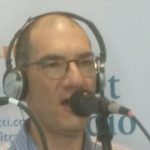

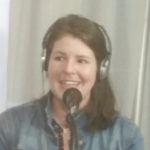
 It drives Amy Sample Ward bananas. Let’s talk through her issues and preventative measures. She’s our social media contributor and the CEO of
It drives Amy Sample Ward bananas. Let’s talk through her issues and preventative measures. She’s our social media contributor and the CEO of 





